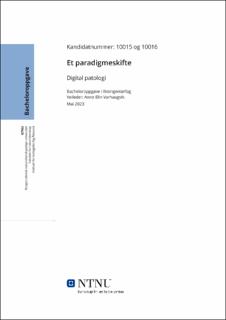| dc.contributor.advisor | Varhaugvik, Anne Elin | |
| dc.contributor.author | Sveen, Maren Frydenberg | |
| dc.contributor.author | Foss, Mari Dalsegg | |
| dc.date.accessioned | 2023-07-04T17:22:27Z | |
| dc.date.available | 2023-07-04T17:22:27Z | |
| dc.date.issued | 2023 | |
| dc.identifier | no.ntnu:inspera:146718045:148986368 | |
| dc.identifier.uri | https://hdl.handle.net/11250/3075888 | |
| dc.description.abstract | Denne bacheloroppgaven tar for seg hvilke utfordringer innføringen av digital patologi har for patologiavdelinger. Flere av Norges sykehus er i oppstartsfasen med å innføre digital patologi, noe som medfører store endringer. Digital patologi er et verktøy som gjør det mulig å skanne histologiske og cytologiske preparater, for å kunne stille en diagnose digitalt istedenfor ved mikroskopering. Årsaken til at mange ønsker å ta det i bruk er for å effektivisere svartiden (diagnostiseringen), forbedre kommunikasjonen mellom avdelinger og sykehus, og bedre kunne håndtere den økende prøvemengden som kommer inn til avdelingen. De erfaringene som er blitt gjort som følge av digitaliseringen har ført til at mange har ulike synspunkter og meninger. Problemstillingen i denne oppgaven er valgt på bakgrunn av dette og er som følger:
Hvilke utfordringer står patologiavdelinger overfor ved innføring av digital patologi og hva er fordelene med å ta det i bruk?
Oppgavens problemstilling ble besvart ved å samle forskningsartikler gjennom litteratursøk ved bruk av søkemotorer. Dette ble gjort for å belyse flere sider av temaet og hvilke utfordringer som kan oppstå. Resultatene viste at digitaliseringen påvirker bioingeniører og patologer ved at arbeidsoppgaver endres, som igjen påvirker arbeidsflyten på avdelingen. Endringen utfordrer det tverrfaglige samarbeidet, utdanning, ergonomi, personvern og tillit, skanning og lagring av preparater. Den nye teknologien øker kravet til kunnskap blant de ansatte, noe som vil ta tid og kreve ressurser. Samtidig bør kvaliteten på arbeidet ivaretas. Digitaliseringen av patologi er uunngåelig og en del av fremtidens patologiavdelinger, men det konvensjonelle mikroskopet vil fortsatt være viktig i diagnostiseringen. | |
| dc.description.abstract | This bachelor thesis examines the challenges that comes with the introduction of digital pathology and how it effects pathology departments. Several of Norway´s hospitals are in the start-up phase of introducing digital pathology, which entails major changes. Digital pathology is a tool that makes it possible to scan histological and cytological slides, in order to diagnose digitally instead of using a microscope. The reason why many people want to use it, is to make the response time (diagnosis) more efficient, to improve communication between departments and hospitals, and to better handle the increasing number of samples that come into the department. The experiences that have been made as a result of digitization have led to many people having different views and opinions. The issue in this thesis is based on mentioned challenges and is as follows:
Which challenges do pathology departments face when introducing digital pathology, and what are the advantages of using it?
The issue in this thesis was answered by collecting research articles through literature searches using search engines. This was done to clarify several aspects of the topic and what challenges may arise. The results showed that digitization affects biomedical laboratory scientists and pathologists by changing work tasks, which in turn affects the workflow of the department. The changes challenges multidisciplinary collaboration, education, ergonomics, privacy and trust, scanning and storage of slides. The new technology increases the demand for knowledge among employees, which will take time and require resources. At the same time, the quality of the work should be maintained. The digitization of pathology is inevitable and part of the future pathology departments, but the conventional microscope will still be important in diagnosis. | |
| dc.language | nob | |
| dc.publisher | NTNU | |
| dc.title | Et paradigmeskifte - Digital patologi | |
| dc.type | Bachelor thesis | |
